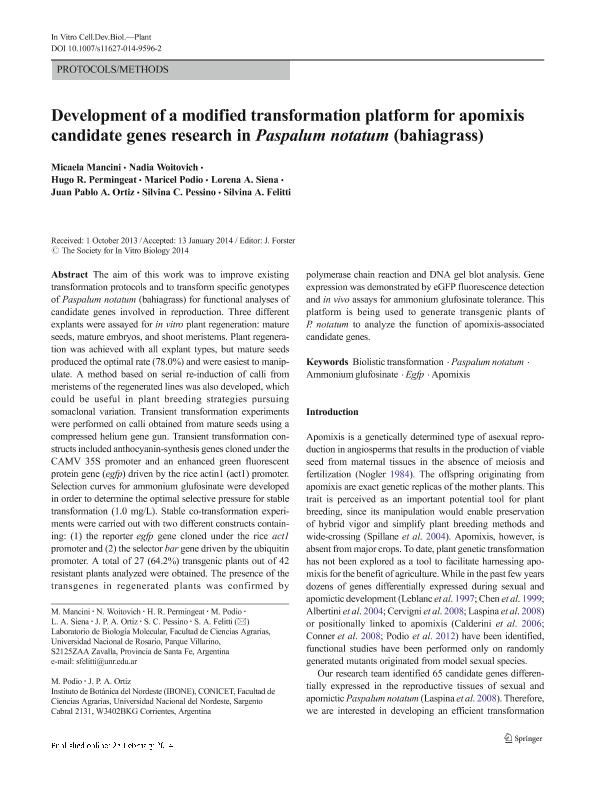Mostrar el registro sencillo del ítem
dc.contributor.author
Mancini, Micaela

dc.contributor.author
Woitovich Valetti, Nadia

dc.contributor.author
Permingeat, Hugo Raúl

dc.contributor.author
Podio, Maricel

dc.contributor.author
Siena, Lorena Adelina

dc.contributor.author
Ortiz, Juan Pablo Amelio

dc.contributor.author
Pessino, Silvina Claudia

dc.contributor.author
Felitti, Silvina Andrea

dc.date.available
2016-01-06T14:53:32Z
dc.date.issued
2014-08
dc.identifier.citation
Mancini, Micaela; Woitovich Valetti, Nadia; Permingeat, Hugo Raúl; Podio, Maricel; Siena, Lorena Adelina; et al.; Development of a modified transformation platform for apomixis candidate genes research in Paspalum notatum (bahiagrass); Springer; In Vitro Cellular; 50; 4; 8-2014; 412-424
dc.identifier.issn
1054-5476
dc.identifier.uri
http://hdl.handle.net/11336/3370
dc.description.abstract
The aim of this work was to improve existing transformation protocols and to transform specific genotypes of Paspalum notatum (bahiagrass) for functional analyses of candidate genes involved in reproduction. Three different explants were assayed for in vitro plant regeneration: mature seeds, mature embryos, and shoot meristems. Plant regeneration was achieved with all explant types, but mature seeds produced the optimal rate (78.0%) and were easiest to manipulate. A method based on serial re-induction of calli from meristems of the regenerated lines was also developed, which could be useful in plant breeding strategies pursuing somaclonal variation. Transient transformation experiments were performed on calli obtained from mature seeds using a compressed helium gene gun. Transient transformation constructs included anthocyanin-synthesis genes cloned under the CAMV 35S promoter and an enhanced green fluorescent protein gene (egfp) driven by the rice actin1 (act1) promoter. Selection curves for ammonium glufosinate were developed in order to determine the optimal selective pressure for stable transformation (1.0 mg/L). Stable co-transformation experiments were carried out with two different constructs containing: (1) the reporter egfp gene cloned under the rice act1 promoter and (2) the selector bar gene driven by the ubiquitin promoter. A total of 27 (64.2%) transgenic plants out of 42 resistant plants analyzed were obtained. The presence of the transgenes in regenerated plants was confirmed by polymerase chain reaction and DNA gel blot analysis. Gene expression was demonstrated by eGFP fluorescence detection and in vivo assays for ammonium glufosinate tolerance. This platform is being used to generate transgenic plants of P. notatum to analyze the function of apomixis-associated candidate genes.
dc.format
application/pdf
dc.language.iso
eng
dc.publisher
Springer

dc.rights
info:eu-repo/semantics/openAccess
dc.rights.uri
https://creativecommons.org/licenses/by-nc-sa/2.5/ar/
dc.subject
AMMONIUM GLUFOSINATE
dc.subject
APOMIXIS
dc.subject
BIOLISTIC TRANSFORMATION
dc.subject
EGFP
dc.subject
PASPALUM NOTATUM
dc.subject.classification
Biología Celular, Microbiología

dc.subject.classification
Ciencias Biológicas

dc.subject.classification
CIENCIAS NATURALES Y EXACTAS

dc.subject.classification
Ciencias de las Plantas, Botánica

dc.subject.classification
Ciencias Biológicas

dc.subject.classification
CIENCIAS NATURALES Y EXACTAS

dc.title
Development of a modified transformation platform for apomixis candidate genes research in Paspalum notatum (bahiagrass)
dc.type
info:eu-repo/semantics/article
dc.type
info:ar-repo/semantics/artículo
dc.type
info:eu-repo/semantics/publishedVersion
dc.date.updated
2016-03-30 10:35:44.97925-03
dc.journal.volume
50
dc.journal.number
4
dc.journal.pagination
412-424
dc.journal.pais
Alemania

dc.journal.ciudad
Berlín
dc.description.fil
Fil: Mancini, Micaela. Universidad Nacional de Rosario. Facultad de Ciencias Agrarias. Laboratorio de Biología Molecular; Argentina
dc.description.fil
Fil: Woitovich Valetti, Nadia. Universidad Nacional de Rosario. Facultad de Ciencias Agrarias. Laboratorio de Biología Molecular; Argentina. Consejo Nacional de Investigaciones Científicas y Técnicas. Centro Cientifico Tecnológico Rosario; Argentina
dc.description.fil
Fil: Permingeat, Hugo Raúl. Universidad Nacional de Rosario. Facultad de Ciencias Agrarias. Laboratorio de Biología Molecular; Argentina
dc.description.fil
Fil: Podio, Maricel. Universidad Nacional de Rosario. Facultad de Ciencias Agrarias. Laboratorio de Biología Molecular; Argentina. Consejo Nacional de Investigaciones Científicas y Técnicas. Centro Científico Tecnológico Nordeste. Instituto de Botánica del Nordeste (i); Argentina
dc.description.fil
Fil: Siena, Lorena Adelina. Universidad Nacional de Rosario. Facultad de Ciencias Agrarias. Laboratorio de Biología Molecular; Argentina. Consejo Nacional de Investigaciones Científicas y Técnicas. Centro Cientifico Tecnológico Rosario; Argentina
dc.description.fil
Fil: Ortiz, Juan Pablo Amelio. Universidad Nacional de Rosario. Facultad de Ciencias Agrarias. Laboratorio de Biología Molecular; Argentina. Consejo Nacional de Investigaciones Científicas y Técnicas. Centro Científico Tecnológico Nordeste. Instituto de Botánica del Nordeste (i); Argentina
dc.description.fil
Fil: Pessino, Silvina Claudia. Universidad Nacional de Rosario. Facultad de Ciencias Agrarias. Laboratorio de Biología Molecular; Argentina. Consejo Nacional de Investigaciones Científicas y Técnicas. Centro Cientifico Tecnológico Rosario; Argentina
dc.description.fil
Fil: Felitti, Silvina Andrea. Universidad Nacional de Rosario. Facultad de Ciencias Agrarias. Laboratorio de Biología Molecular; Argentina. Consejo Nacional de Investigaciones Científicas y Técnicas. Centro Cientifico Tecnológico Rosario; Argentina
dc.journal.title
In Vitro Cellular

dc.relation.alternativeid
info:eu-repo/semantics/altIdentifier/url/https://link.springer.com/article/10.1007/s11627-014-9596-2
dc.relation.alternativeid
info:eu-repo/semantics/altIdentifier/doi/http://dx.doi.org/10.1007/s11627-014-9596-2
Archivos asociados
